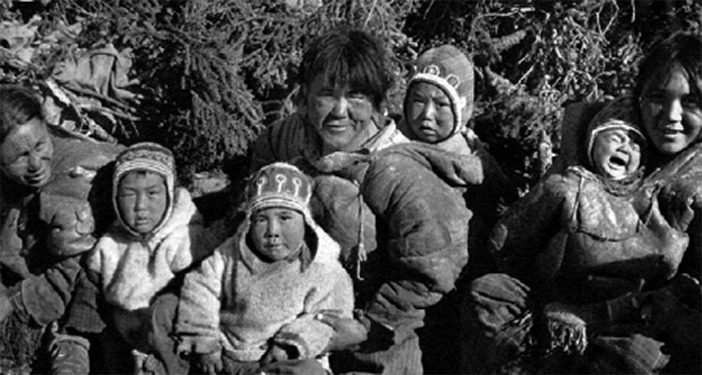Canada’s genocide: The case of the Ahiarmiut
OPINION: The forced relocation of a group of Inuit in Canada's Arctic constitutes genocide.

As a human rights scholar, I have long argued that Canada committed cultural genocide against Indigenous peoples. But recently, I’ve come to conclude, in the case of the Ahiarmiut, that it’s not cultural genocide — it’s actual physical genocide.
An article in the Globe and Mail last summer by Gloria Galloway told the story of what happened to the Ahiarmiut, a small group of Inuit in 1950.
The Canadian government forcefully relocated them 100 kilometers from their original home in what is now Nunavut. The government’s reason for moving the Ahiarmiut people was that they were becoming too dependent on trade with federal employees at a nearby radio tower.
Galloway got much of her information from David Serkoak, an Elder who lived through the relocations. Recently, Serkoak collaborated with the Canadian Museum for Human Rights to tell his story and to be a storyteller for his community.
Brutal relocations
The Canadian government moved the Ahiarmiut to an isolated island and did not provide them with food, shelter or tools.
To survive, they ate bark and other scavenged food until winter came. Many died. In 1957, they were relocated again. They were given tents, as well as a “starvation box” that might feed them for a week. Many more died.
There were three more relocations after this.
The way Canada’s government treated the Ahiarmiut is similar to the way the Soviet Union treated several minority groups in 1944 including the Tartars, the Chechens and ethnic Koreans. Trainloads of people were sent to Siberia and left without food, clothing and shelter.
Up to 50 percent died, just like the Ahiarmiut people. Scholars recognize the Soviet Union’s actions as genocide.
Legally genocide
You might ask whether the term “genocide” can be applied to a group as small as the Ahiarmiut. Yes, it can. The United Nations adopted a Convention on the Prevention and Punishment of the Crime of Genocide in 1948.
The UNGC does not say that genocide requires a minimum number of victims. It also refers to the destruction of groups “in whole or in part.” The entire group doesn’t need to die for a deportation to be considered genocide.
In sociological terms, rather than legal, Helen Fein, a genocide scholar, coined the term “genocide by attrition.” This means the genocide takes a while, with victims dying of starvation and disease rather than outright murder.
I suspect that there’s been a lot of genocide by attrition of Indigenous peoples in Canada.
For example, in 2018, the government is still promising to clean up the rivers in Grassy Narrows, Ontario. Indigenous people in Grassy Narrows have been suffering and dying from water-borne mercury poisoning for decades.
Our government has known about this since the 1980s, yet it continues.
In legal terms, the only reason not to call the deportations of the Ahiarmiut genocide is the question of intent. The UNGC specifies that actions constituting genocide must be accompanied by “an intent to destroy” the group in question.
Perhaps Canadian bureaucrats did not intend that the Ahiarmiut should die. Perhaps they believed that Indigenous people could survive even if they were left on an isolated cold island they had never lived on before and where they were given no shelter, tools or food.
Even so, when Canada deported the Ahiarmiut, it violated its international commitments to the Universal Declaration of Human Rights which Canada voted for on Dec. 10, 1948. This was a declaration, not a legal treaty. But it implied a commitment to all human rights, including rights to adequate food and protection from starvation, the right to housing and the right to health.
Canada signed the UNGC on Nov. 28, 1949, although it did not ratify it (the second step to accepting legal obligations) until Sept. 3, 1952.
Had anyone with political authority noted in 1950 that Canada was committing genocide against the Ahiarmiut, the government could have argued that it had not yet ratified the UNGC, so it was in the clear. And the government could have argued that although it accepted the UDHR rights to health, shelter and food in principle, it did not yet have to provide them.
More likely though, to the Canadian government, Indigenous people at the time were disposable. The government could move them when and where it wanted, for whatever reason it wanted.
Reparations and apology
From 1927 to 1951 it was illegal for Indigenous peoples in Canada to organize or meet, making it extremely difficult to resist these brutal acts.
Ahiarmiut survivors have asked for reparations and an apology. The Canadian government and the Inuit have recently agreed to settle, in part to bring “closure” to this event.
If ever a group of Indigenous people were entitled to apology, memorialization and compensation, it is the Ahiarmiut. But more than that, the Ahiarmiut are entitled to an acknowledgement by the Canadian government that they were victims of genocide.
Rhoda E. Howard-Hassmann is professor emeritus in the department of political science at Wilfrid Laurier University.
This article is republished from The Conversation under a Creative Commons license. Read the original article.
The views expressed here are the writer’s and are not necessarily endorsed by ArcticToday, which welcomes a broad range of viewpoints. To submit a piece for consideration, email commentary (at) arctictoday.com.